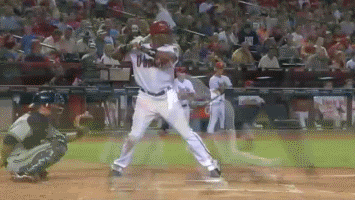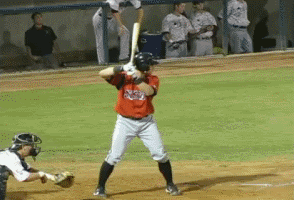James Darnell has hit at every level of baseball he’s played at including three years in the tough SEC and his current time at High-A with Lake Elsinore. A very strong young man with solid swing fundamentals and big time college experience can usually do very well in the lower levels of the minors. “Solid” is the word that comes to mind when I watch Darnell hit, and I'll tell you why. Solid build, solid swing, and very solid production; but is his ceiling any higher than being just a “solid” player?
Similar In Style, Different In Execution
Darnell’s swing is similar in style to Justin Upton, but that is not to say that he is the same talent and will have the same production in the Major Leagues as Upton. No one will confuse him for the freak athlete that Upton is, but watching them swing, one can see some stylistic similarities in the two hitters. But there are some definite mechanical differences, and Darnell's differences do pose a chance of possible struggles down the road. Thankfully their styles are so close that learning from Upton could be relatively easy.


Lower Body
Darnell starts with a good base and enough of a crouch to be in an athletic position. As he prepares to swing he sways back and lifts his front leg up and back to gain some momentum to move forward with. His front leg coil gives his lower half a running start and the ability to have a quick and powerful unload into the ball.
Darnell is a rhythm and momentum hitter. He stays on his backside fairly well, and gets a good weight shift through the ball. The good part of being a momentum hitter is that you will always get a very good weight shift and be able to direct all of your energy into and through the ball.
The downside of being a momentum hitter is the habit of shifting your weight too soon. Ideally you want to shift your weight as part of the launch, not before it. Momentum hitters often fall into a shift-then-swing pattern. An all-back-all-forward movement, like Darnell's, creates timing problems and bleeds off energy stored from loading. This could affect his ability to be able to stay back on good off-speed pitches, similar to Upton's early '09 struggles.
Darnell strides with his front foot, different from Upton who puts his front foot down with his rear leg. You can see this by focusing on each hitters' front leg. Upton just picks his up and puts it back down as he moves forward. He's letting his rear leg do the work, and letting his backside open up his front side as he swings. Darnell's front leg goes up and lifts his foot over an imaginary block. His front hip opens up a little prematurely, and is slightly pulling to open his hips. If his backside were to open up his front like Upton does, Darnell would be less prone to bouts of shifting his weight early, like he is now, and would be far more explosive.
Upper Body
Darnell is calm in his upper body with very little movement. He has a small load and throws the bat down into the hitting zone with his hands. This is not supremely efficient and forces him to make contact a little more out in front than would be preferred.
Darnell produces solid bat speed and has decent swing quickness. He has a flat swing plane,but doesn't have a lot of lift in his swing. He is very direct to the ball, and stays inside it well.
What Needs To Improve
Comparing the video of each, you can see that Darnell needs to tighten up his hand path to the ball. You can also see in the Gif's that Upton pivots the bat in his hands behind him, while Darnell throws his hands directly into the hitting zone. These are big differences in the ability to whip the barrel. Upton is far better at whipping the bat from behind, while Darnell doesn't get much whip in his swing, and when he does, he whips out in front of him.
Learning to whip from behind him instead of throwing the barrel out in front could help Darnell improve the efficiency of his unload. He would go from throwing or pushing the bat to whipping the bat into contact. When you throw the bat out in front, you rob yourself of time and you aren't as strong to the ball as you could be.
Better Efficiency
The simple fix to tighten up Darnell's upper unloading pattern is to have his hands and rear should work more in unison. But, his load could also be improved which would improve his upper body stretch as well. A more aggressive loading action with his hands would drastically increase his stretch and his ability to generate behind him instead of out in front. He has calm upper body actions, but a more aggressive loading action could possibly push him to new levels of bat speed and power.
If Darnell were to improve his load and/or get his rear shoulder to go quicker to the ball he could improve the quickness and efficiency of his swing. Some slop -- path not tight and direct -- would be removed, and he would be able to maintain his already solid bat speed along with some new found swing quickness. His current load slightly cuts the wire tying his hands to his rear shoulder -- see the Brandon Allen report for a better description -- which is where some of the slop comes in. Maintaining a good hand and shoulder relationship combined with a more aggressive load would enhance his ability to whip from behind . He wouldn't have to throw the bat out in front to stay quick. He could wait and unleash his energy far more efficiently. As of right now, he generates his swing out in front of him. Generating behind and doing so aggressively would unleash a whole new level of bat speed and power.
Upton's load isn't aggressively large, but the aggression and intent is largely different than Darnell's. Upton gathers himself and prepares to swing with bad intentions. Darnell is more relaxed and smooth. I'm not saying Darnell needs a huge mechanism to get his bat started, but aggressively preparing to swing with intent to cause harm to a pitcher's ego is what's missing from Darnell's swing. How much or how little Darnell would load is up to him, but the intent is the biggest thing.
Dialing In The Lower Body
As I covered earlier, Darnell is a momentum hitter. At times, he gets a little jumpy with his front leg to catch up to the increased velocities, though he does do a good job of keeping his head behind the ball. This helps him see the ball deep, and explains his outstanding 87 walks in 126 total games this season.
Darnell has very little separation between his upper and lower half, and he might not be generating as much bat speed as he could. Again, as I touched on in the Brandon Allen report, this affects his ability to resist with his hands as well as doesn't give him the ability to let his hips pull his hands through the zone, which is basically free bat speed when done properly. Better separation would give him better body control and more bat speed to bump up his power ceiling.
The more aggressive load I touched on earlier would keep him centered over his rear leg as he moves forward, and the aggressive negative movement of his hands as his lower body opens would create his much needed separation.
Closing Thoughts
I mentioned the word “solid” nine times so far including this last one. And that is not because there is a lack of other words to describe Darnell’s game. It's just the most fitting one. Darnell has the tools, ability, and swing to be a very solid offensive 3rd baseman. Twenty home runs and a .960 OPS between Low-A Fort Wayne and High-A Lake Elsinore is certainly nothing to scoff at. But, the real test for Darnell will come at the Double-A and Triple-A levels. Then we will find out if he is just a polished college hitter pounding A-ball pitching, or a legitimate prospect. If he can improve his upper body pattern and make a few other refinements, he could go from a potential Casey Blake with patience type, and move toward his ceiling of a pre-2009 breakout Ryan Zimmerman with a higher on base percentage.
Direct questions and comments for Steve in our Scouting forum. Or you can reach him at stevecarterpp@hotmail.com
